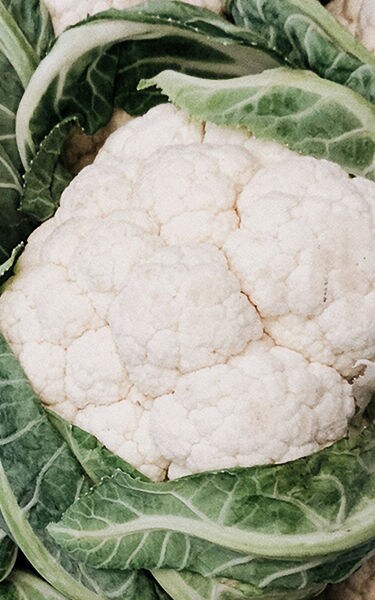The cauliflower is a versatile vegetable that is perhaps best known for its oft-touted wellness properties. It has a great ability to blend into its culinary environment, providing body and bulk in low-carb recipes. The cauliflower’s cool-weather ripening and superior storage abilities make it a fall and winter staple for everything from casseroles to soups or salad, and it’s found a home in surprising places, including pizza crusts!
This vegetable is loaded with vitamins: 1 cup contains about 75% of your recommended daily intake of vitamin C. Try adding a nutritional punch to your dinner by making our faux alfredo sauce with cauliflower. And every part of it, from the stems to leaves, is edible! The florets are the part of the cauliflower most often steamed or roasted (but can also be eaten raw or pickled), but don’t throw out the leaves and stems. These parts of the vegetable are often tossed away, but instead cut down on food waste and save them to add them to homemade vegetable broth!
Where to Buy Cauliflowers
Cauliflowers may be grown, harvested, and sold year-round, but they are by nature a cool-weather crop. Sunshine and heat bring out bitter flavors in the undeveloped flower buds, whereas chill and frost bring out their sweeter side. While you will find cauliflowers in nearly any market at any time of the year, they are at their best in the fall and winter and even into early spring. This is when you’ll also find the lowest prices, though they’re always relatively inexpensive. They’re sold fresh by the full head and as pre-cut and packaged florets both fresh and frozen.
How to Cook With Cauliflowers
Raw cauliflower is often combined with creamy dips and is a popular addition to a a raw vegetable or crudite platter. Cauliflower can be roasted, steamed, sauteed, or fried. You can also mash cauliflower to serve as a side dish similar to potatoes.
Whether cooked or eaten raw, cauliflowers are most commonly broken or cut into florets. Any outer leaves are removed, which can be cut up and added to a stir-fry or soup. The core is often removed and discarded, but it is just as edible and tasty as the florets. Feel free to chop it up and cook those pieces along with the florets, especially if you’re making any kind of cauliflower soup. The entire head of the cauliflower can also be roasted for a stunning presentation.
Storage
Keep cauliflowers loosely wrapped in a glass storage container in the refrigerator. Fresh from the market, heads will last up to two weeks. Cut the cauliflower into florets and store sealed in a storage bag in the fridge for up to a week. For longer storage, the florets are best blanched and frozen and will keep up to a year. Check out our article to learn more about how to use your fridge more efficiently.
Varieties
The pillowy white heads of cauliflowers are the most familiar and recognizable, but there are other varieties available. You may also find Italian purple cauliflowers or golden cauliflower heads at some markets. The Veronica Romanesco Hybrid (commonly called “broccoflower”) is most unique, with its green, pointy florets that look more like a succulent than a vegetable. These are fun alternatives (particularly for vegetable platters) and can be used just like the more common white cauliflower.
Source
1. https://www.thespruceeats.com/what-is-cauliflower-4772294
2. https://www.chatelaine.com/recipes/chatelainekitchen/vegetable-facts-things-you-didnt-know-about-cauliflower/
Share



